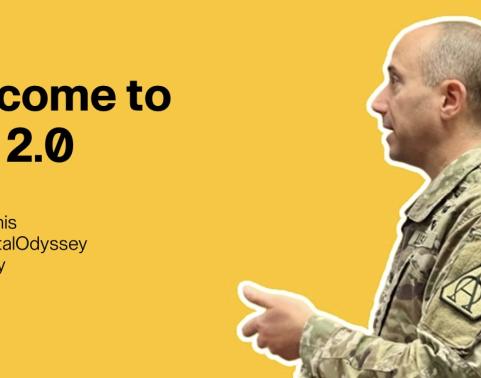Welcome to AIE 2.0

Imagine you are an Army recruiter. Your mission is to recruit qualified young men and women into the Army, which is essential to building the military’s strength and readiness.
You visit schools, attend community events and schedule appointments with students to connect with potential recruits. But your day is bogged down in administrative tasks — like updating an application record — that can only be accomplished after logging into your computer, connecting to a virtual private network and booting up a business application. You also have to squeeze physical training into your day.
“Our goal with Accessions Information Environment (AIE) is to keep that recruiter moving out within the community instead of behind a desk in their office,” Master Sgt. Nicholas Vinson, AIE product owner at the U.S. Army Training and Doctrine Command, said June 20 at AIE Industry Day.
Leveraging a cloud-based Customer Relationship Management platform, AIE will enable recruiters to generate and manage leads in a mobile app, connect with potential recruits, streamline enlistment-process paperwork, replace trainees’ paper check-ins with electronic check-ins and much more.
AIE 2.0
AIE rebooted to AIE 2.0 this year after refining its approach to software development. The new approach reflects the Army’s guidance and industry best practices documented in Army Directive 2024-02, a game-changing policy memo released in March.
To support AIE, industry needs to bring “a demonstrated ability to execute Agile software projects” and “a West Coast mentality to software development, not a Beltway mentality,” said Col. (Promotable) RJ Mikesh, deputy program executive officer for PEO EIS.
In addition to pivoting to Agile best practices, the AIE 2.0 reboot includes maximizing Salesforce out-of-the-box capabilities, adopting a new contracting strategy and expanding competition, according to Col. Matthew Paul, project manager for Integrated Personnel and Pay System — Army (IPPS-A).
“We are maximizing commercial out-of-the-box solutions to the extent practical and trying to avoid one-off customizations wherever we can,” Paul said. “And when we do need to customize, we are going to do so smartly, deliberately and responsibly.”
“We have a renewed focus in using Salesforce out-of-the-box as much as possible, but we are also interested in innovative, complementary capabilities that will enhance AIE functionalities,” Valarie Tran, AIE’s new product lead said.
AIE decomposed its contracting strategy. “Instead of giving one big contract to an integrator to do everything, we disaggregated our approach,” Paul said. “We have a direct contractual relationship with Salesforce. We are pivoting into a multi-vendor environment and to an Agile, continuous integration, continuous deployment methodology.”
“We are looking for a very collaborative environment where everybody works together,” said Jay Patnaude, AIE’s acting technical lead.
10-year, multi-award contract
AIE will award a 10-year, multi-award, indefinite-delivery, indefinite-quantity contract. “We are going to onboard multiple vendors that can meet our requirements, and those industry partners are going to compete at the task-order level,” Paul said, noting that the contracting strategy will maximize competition, drive innovation and control total lifecycle costs.
The Army will play the role of a release train engineer to set vendors’ priorities and monitor their performance, according to Paul. “We are not buying specific products,” Paul said. “We are buying capacity that is capable of going fast in a Scaled Agile Framework® (SAFe® 6.0) model.”
Army recruiting transformation
The Army is implementing transformative changes to build a better recruiting force, according to Brig. Gen. Fred Hockett Jr., deputy commanding general-support for the U.S. Army Recruiting Command (USAREC).
“AIE will enhance prospecting, processing and future Soldier management,” Hockett said, noting that AI can help Army recruiters identify prospects who have a higher propensity to enlist, while ensuring we retain the applicants who have decided to enlist.
AIE needs “to be intuitive,” Hockett said. “We don't want to spend 80 hours training somebody how to operate a system.”
Hockett emphasized that AIE will be built within an environment of experimentation and innovation. “We need to rapidly respond to the ideas that come from the field,” Hockett said.
AIE 2.0 early adopters
AIE plans to deploy an initial capability to the Ohio Army National Guard Recruiting and Retention Battalion. “Our goal is to get our capability into the hands of the users as soon as possible to capitalize on that real-world, on-the-ground feedback to make AIE better,” Vinson said.
AIE will eventually support more than 25,000 users at the Army Cadet Command, Army Center for Initial Military Training, Army Enterprise Marketing Office, Army National Guard and USAREC.
Links
- Video: AIE Industry Day (June 20, 2024)
- Slide Deck: AIE Industry Day (June 20, 2024)
- AIE draft RFP (May 3, 2024)
- AIE RFI (March 28, 2024)
Work for Us
Join a winning team! Search for job opportunities with PEO Enterprise.
Work with Us
Help support important missions. Explore ways your company can work with PEO Enterprise.